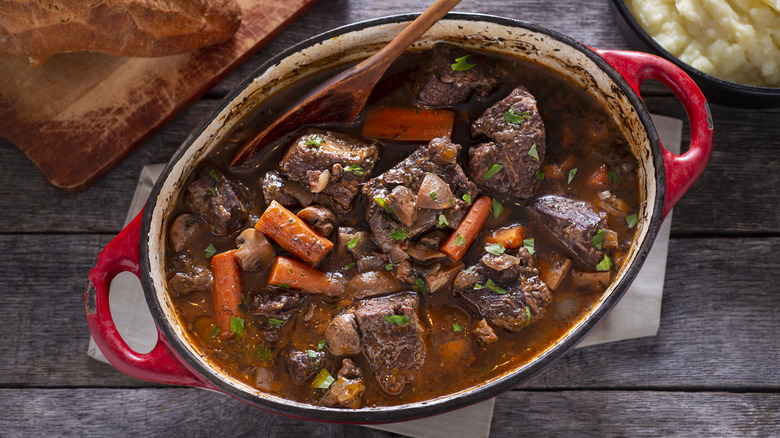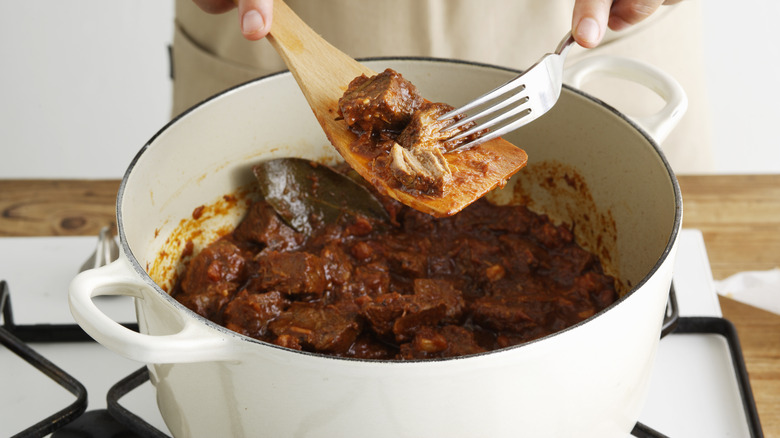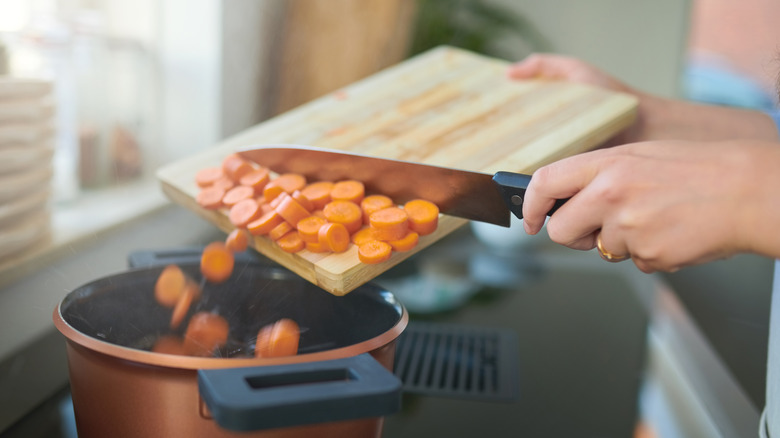The Timing Mistake That's Killing Your Beef Stew
There are plenty of common mistakes people make when it comes to beef stew, but not giving the dish enough time to cook is one of the easiest ones to avoid. When you give the stew enough time, you get the tender, melt-in-your-mouth texture you crave instead of the tough, chewy beef that undercooking produces. The key to perfect beef stew lies in being aware of this fact. Rushing through the process might get the food on the table sooner, but it will cost you dearly in flavor and texture.
Beef stew needs to be cooked long enough to break down tough connective tissues like collagen. When done properly, this process gives the stew a rich, silky texture. Undercooking the beef leaves the tissues intact, resulting in a dish that's far from the hearty comfort food it's meant to be. Cooking slowly also allows flavors to meld and develop, making the dish tastier. Ultimately, properly timing your beef stew ensures each bite is tender and packed with deep, savory flavor — making it well worth the wait. Whether you're cooking in a slow cooker, on the stovetop, or in the oven, the principle remains the same: low and slow is the way to go.
Cook beef stew low and slow
Cooking beef stew low and slow is the key to achieving tender, delicious meat. When cooking on the stovetop or oven, follow the recipe directions and ensure you're aiming for about two hours of cook time. Begin checking the texture a little earlier than the recipe instructions so you find the sweet spot. If you're using a slow cooker, follow the recipe guidelines, but keep in mind that checking earlier can help you avoid overcooking and ending up with mushy meat.
The "low" part of "low and slow" is just as important as timing. When meat is cooked slowly at a lower temperature, the muscle fibers don't contract as quickly, helping the meat stay tender and juicy. Cooking beef stew low and slow also allows for an even distribution of heat throughout the meat, so everything cooks uniformly. This gives the collagen and other connective tissues time to break down, turning tough cuts of beef into tender, melt-in-your-mouth bites.
Before you begin the cooking process, be sure to brown the meat. Browning adds a depth of flavor and helps lock in the juices. For quicker browning and a more flavorful stew, consider searing a whole roast before cutting it into smaller pieces for the stew.
Watch the veggies' timing too
Timing also matters when it comes to adding veggies to your stew. For heartier vegetables like potatoes, carrots, and parsnips, cutting them into larger, uniform pieces — about 1 to 1.5 inches — will ensure they cook evenly and hold their shape. These types of vegetables should be added about halfway through the cooking process to allow them to become tender without turning to mush. If you're using smaller cuts, be sure to reduce the cooking time accordingly, as they will cook faster and can become overly soft if added too early. This step is especially important if you're aiming for a stew with varied textures.
Delicate vegetables can be added a few minutes before the stew is finished cooking, which allows them to warm through without losing their crispness or color. Leafy greens like spinach and kale need only a brief cooking time to soften slightly while still retaining their structure. Green beans and peas also benefit from minimal cooking, which preserves their crunchy texture and bright hue. Finally, if you find that your stew needs thickening, you can blend a portion of the broth and vegetables into a slurry to achieve your desired texture.


